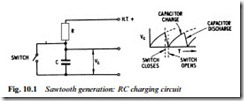RAMP GENERATORS
The sawtooth drive waveform required by a field timebase is called a ramp, and of several possible methods of generating it, the simplest is to use a series RC charging circuit. Fig. 10.1 shows the principle, in which capacitor C is allowed to charge towards HT potential via series resistor R. Each time the switch across the capacitor is closed the capacitor rapidly discharges to form the flyback stroke of the scanning spot. As the waveform in Fig. 10.1 shows, however, the saw- tooth’s forward stroke is not linear. As the capacitor charges the volt- age across the resistor diminishes, with a corresponding reduction of current. In this series circuit the reducing resistor current flows also into the capacitor, and this diminution of charging current with time is responsible for the curvature in the waveform. It can be overcome by charging the capacitor from a constant-current source. In its simplest form this may consist of a very high HT potential and very large resistor R; provided the charging process has not advanced far towards VHT before the flyback switch closes the charging current is substantially constant, and the resulting ramp substantially linear. This configuration is inconvenient for modern IC circuit design, where a constant-current generator is easily arranged in the emitter circuit of an internal transistor.
